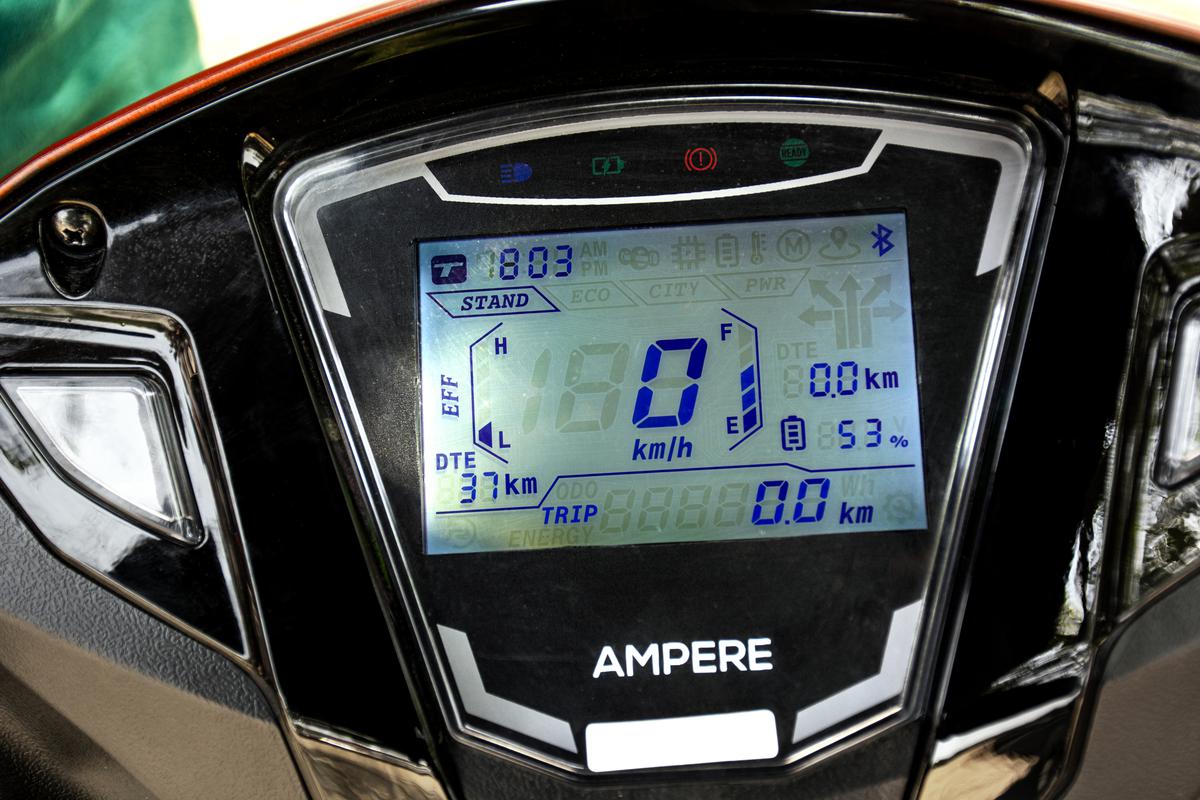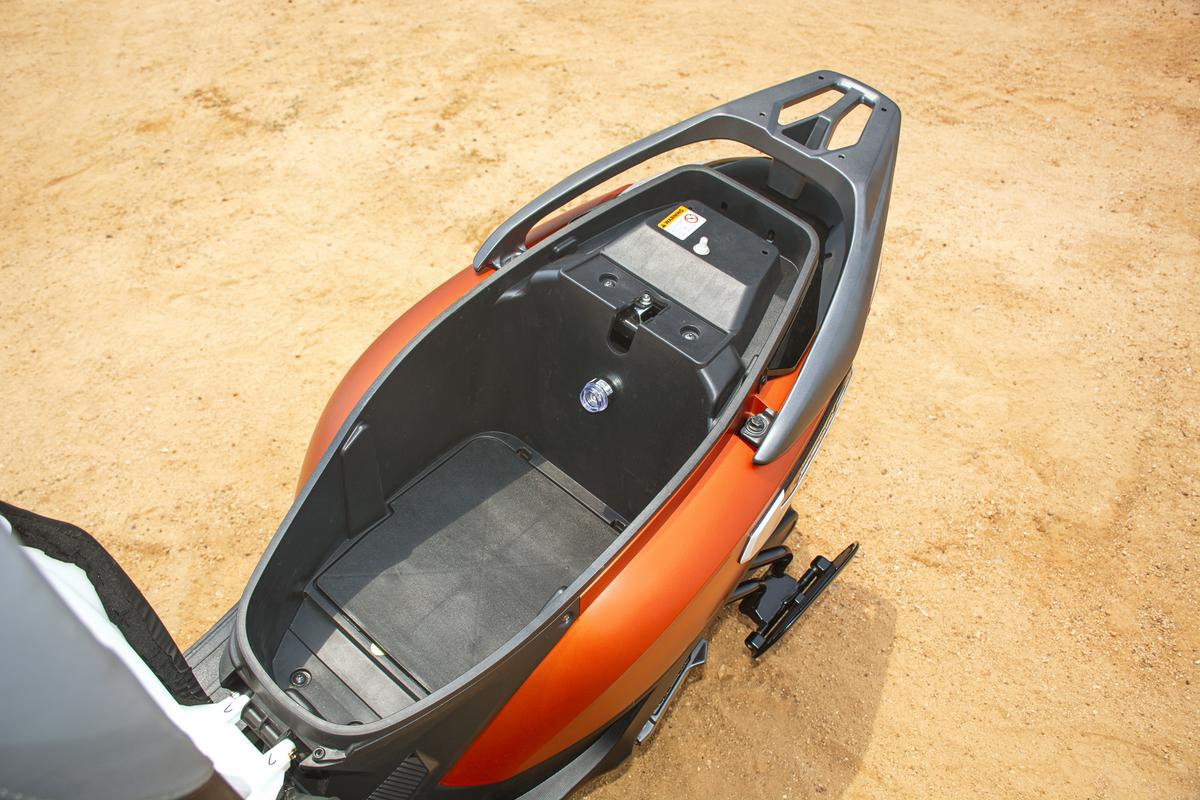Ampere is one of the bigger players in the ocean of EV “start-ups” in India selling e-scooters designed and developed abroad. In 2018, the company was acquired by Greaves Cotton Ltd, and while Greaves has no prior experience with electric mobility, it has a vast and varied engineering background. This factor comes into play with the launch of the new Primus – the company’s first truly indigenous, Made-in-India, Made-for-India offering. We present a brief spin on the e-scooter.
Within the Ampere line-up, the Primus sits at the top – priced at ₹1.10 lakh (ex-showroom, India, except North Eastern states). And in the e-scooter market it’s a tad below the base variant of the TVS iQube (in most cities; but in a few others, the iQube is cheaper), and on par with the Ola S1 Air in its costliest 4kWh guise.
A quick glance at the spec sheet reveals some similarities with the iQube. There’s a 4kW mid-mounted motor here that delivers a claimed 0-40kph time of 4.2sec and a claimed top speed of 77kph – both figures almost identical to the TVS. However, in the real world the parallels are not so strong. The Primus doesn’t have the zip you’d expect from a 4kW e-scooter. Right off, it doesn’t feel as peppy as an iQube, and acceleration drops significantly above 40 kmph.
That said, it continues to gain momentum steadily and will eventually cross the speedo-indicated 80kph. Hence the overall performance levels are sufficient for everyday city commuting. But even the performance will not entertain you.
Giving the Primus its go-to juice is a 3kWh LFP battery – a chemistry that offers safe thermal characteristics but slightly lower energy density than its more widespread NMC counterpart. It’s a non-removable unit located under the seat, and offers an ARAI-certified range of 107km, though you probably won’t get that much in real-world conditions. We spent most of the day in the highest ‘Power’ mode, and it looked like the scooter would cover between 70 km and 80 km on a full charge. Once dead, Ampere says a full top-up will take about five hours, while an optional fast charger (price hasn’t yet been announced) cuts this by about half.
We noticed that the SOC indicator is not the most accurate or reliable unit. It dropped from 100% to just 1% after the first 10km ride, and then another 15% over the next 10km, so clearly there is still some work to be done in this area. The DTE readout fluctuates quickly by a large amount depending on riding style at any given time, and it doesn’t inspire confidence.

There were also issues with the smaller, Bluetooth-enabled LCD panel. Apart from the fact that it is dim and difficult to read in sunlight, the single trip meter cannot be reset manually, and instead resets automatically every time the scooter is left for a while goes. Oddly, the clock seems to reset this way, and it’s not possible to manually toggle between the odometer and trip meter on the screen (you see the odo when you turn on the scooter, and once you’re done walking When we start, it turns into a travel distance meter).
Being 5’8 in height, I found the riding position to be a bit too high with the knees on the Primus. Also, there is ample space for both the rider and the pillion, and the floorboard is spacious as well. Underseat storage space is decent at 22 litres. The compartment is wide and fairly tall, but like many other EVs, it’s not deep, so it won’t fit a helmet. There’s also a fairly large cubby with a USB charger behind the apron. Other features include an LED headlight, Bluetooth connectivity, three riding modes and reverse.
Fit levels in the scooter are decent, but there are plenty of other ways in which the Primus feels built for the cost. The materials are not appropriate for something that costs more than ₹1 lakh, and a front drum brake is a bit surprising at this price point. The rest of the chassis package is decent enough, with 12-inch wheels at both ends. Ride quality strikes a nice middle ground—neither soft like the iCube nor harsh like the Aether. It’s sure-footed around the corners, while still giving you comfort on bad patches of road. However, the weak drum brakes really stop you from picking up speed and enjoying the ride on this scooter.

The Ampere Primus is a weird scooter to sum up. At ₹1.10 lakh, it certainly isn’t downright cheap; You can get a far more capable and better equipped petrol scooter for less money. In the electric space, it is affordable compared to most of the established premium e-scooters around, but not by much. If you’re looking for a cost-effective, basic and simple e-scooter, the Primus may be worth considering and the LFP battery has appeal. For most people, though, the extra ₹8,000 that the base TVS iCube (in Mumbai) asks for is worth paying. Strong performance, better seating comfort and a front disc brake justify that premium in themselves, but you also get a clean TFT display, better construction and a stronger reputation.